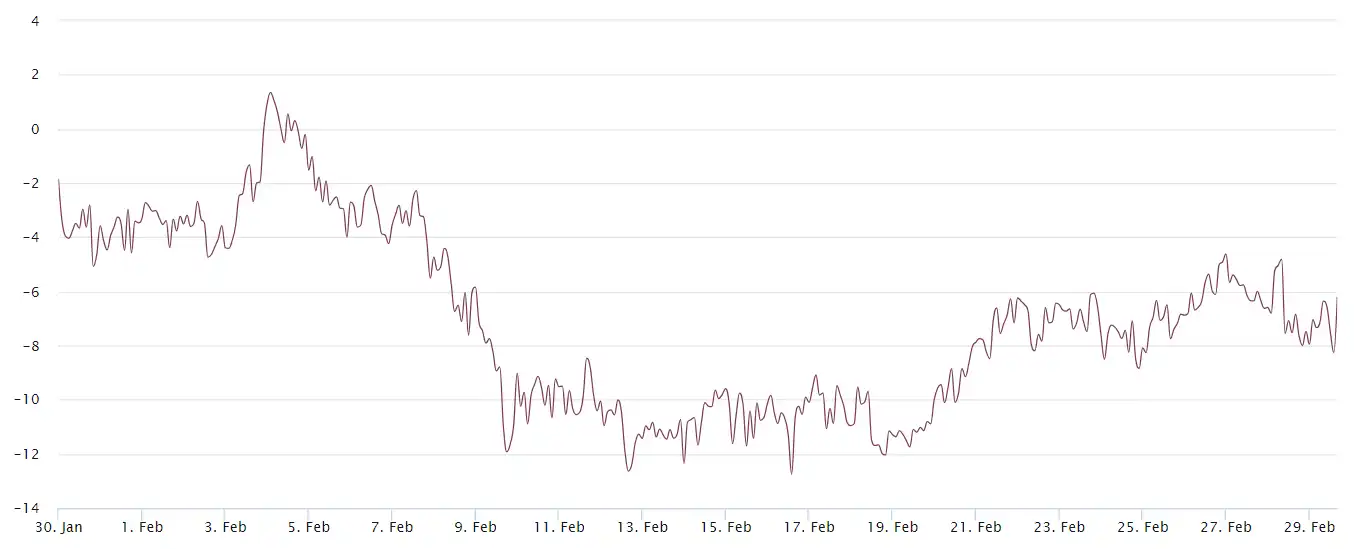Bitcoin traders remain cautious despite recent gains as concerns about spot ETF inflows and U.S. recession linger.
Bitcoin (BTC) has seen a notable surge of 23% in the five-day period ending February 28th. Despite this upward momentum, traders dealing in BTC options seem hesitant to embrace a bullish outlook. The reluctance stems partly from the fact that Bitcoin hasn't experienced a 5% weekly loss in over five weeks, leading traders to seek protection against potential downside risks.
Concerns Surrounding Spot Bitcoin ETF Inflows and U.S. Economic Outlook
Investor concerns have emerged regarding the possibility of a decrease in the substantial inflow into spot Bitcoin exchange-traded funds (ETFs), which could potentially trigger a correction in Bitcoin's price. This indicates that traders may either lack conviction in the current bullish trend or perceive a reduced need for leverage amidst macroeconomic uncertainties.
On February 28th alone, U.S. Bitcoin ETFs witnessed a net inflow of $673 million, accumulating a total of $7.4 billion in net deposits since their launch on January 11th. According to James Seyffart, a senior ETF analyst at Bloomberg, this information is significant, particularly considering that only 150 ETFs have ever surpassed the $10 billion mark in assets under management. Notably, BlackRock's iShares Bitcoin ETF has already amassed over $9 billion in assets, as confirmed by Nate Geraci, co-founder of the ETF Institute.
Interpreting this data reveals two distinct viewpoints. Some argue that such inflows may not be sustainable over the long term, either due to diminishing demand as Bitcoin's price rises or because there's a limit to investors' risk appetite for cryptocurrency exposure. Conversely, certain traders hold a bullish perspective, believing in a "snowball effect," wherein the increasing Bitcoin price could further drive ETF sales, as suggested by analysts at JP Morgan.
Trader beaniemaxi shared their viewpoint on a social network, suggesting that both BlackRock and other spot ETF issuers have incentives to mobilize their sales teams due to the persistent nature of the "Bitcoin narrative." This implies that there's still considerable potential for increased inflows before reaching a saturation point. The post also highlights the Bitcoin halving trigger, indicating a compelling selling argument for ETF issuers.
However, all these hypotheses could be challenged if the economy experiences a severe recession or if investors are compelled to liquidate profitable positions to meet rising financing costs elsewhere. Economist David Rosenberg has predicted an 85% likelihood of a U.S. economic recession in 2024, emphasizing potential significant repercussions on the stock market in such a scenario.
Bitcoin Derivatives Reflect Balanced Demand
To assess the sentiment of professional traders towards Bitcoin, despite its impressive 45% gains in February, it's essential to analyze the BTC options markets. The 25% delta skew serves as a valuable indicator, revealing when arbitrage desks and market makers are pricing upside or downside protection excessively.

The Bitcoin options 25% delta skew has maintained a neutral stance since February 20th, fluctuating between -7% and +7%. This suggests a balanced pricing between call (buy) and put (sell) options. Interestingly, traders became less optimistic just six days after Bitcoin failed to breach the $52,500 mark, highlighting investor anxiety during accumulation phases.
Irrespective of whether market makers are offering downside protection at a discount compared to upside exposure, it's crucial to cross-reference data from BTC futures markets to gauge the positioning of top traders. This indicator consolidates positions across spot, perpetual, and quarterly futures contracts, providing a comprehensive view of traders' bullish or bearish sentiments.

The data suggests that top traders at exchanges like Binance and OKX remained relatively neutral until February 26th, gradually increasing net long positions as Bitcoin's price surpassed $53,000. While this evidence partially contradicts Bitcoin skew data, it could be attributed to the forced liquidation of short positions, indicating the abrupt end of bearish bets.
Moreover, traders at OKX haven't even reached their highest monthly level in long-to-short ratios, making it challenging to argue for widespread bullish sentiment among professional traders at present. Consequently, if spot ETF inflows persist, skeptical traders may find themselves needing to adjust their positions to align with market trends.
This article provides general information and should not be considered legal or investment advice. The views expressed herein are solely those of the author and do not necessarily reflect the views of Cointelegraph.

